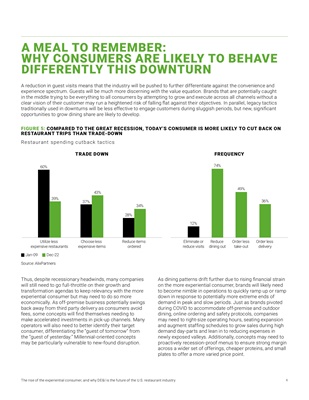
The rise of the experiential consumer, and why DE&I is the future of the U.S. restaurant industry 6
A MEAL TO REMEMBER:
WHY CONSUMERS ARE LIKELY TO BEHAVE
DIFFERENTLY THIS DOWNTURN
A reduction in guest visits means that the industry will be pushed to further differentiate against the convenience and
experience spectrum. Guests will be much more discerning with the value equation. Brands that are potentially caught
in the middle trying to be everything to all consumers by attempting to grow and execute across all channels without a
clear vision of their customer may run a heightened risk of falling flat against their objectives. In parallel, legacy tactics
traditionally used in downturns will be less effective to engage customers during sluggish periods, but new, significant
opportunities to grow dining share are likely to develop.
FIGURE 5: COMPARED TO THE GREAT RECESSION, TODAY'S CONSUMER IS MORE LIKELY TO CUT BACK ON
RESTAURANT TRIPS THAN TRADE-DOWN
60%
37%
28%
39%
43%
34%
12%
74%
49%
36%
Restaurant spending cutback tactics
TRADE DOWN FREQUENCY
Source: AlixPartners
Dec-22
Jan-09 Utilize less
expensive restaurants
Choose less
expensive items
Reduce items
ordered
Eliminate or
reduce visits
Reduce
dining out
Order less
take-out
Order less
delivery
Thus, despite recessionary headwinds, many companies
will still need to go full-throttle on their growth and
transformation agendas to keep relevancy with the more
experiential consumer but may need to do so more
economically. As off-premise business potentially swings
back away from third party delivery as consumers avoid
fees, some concepts will find themselves needing to
make accelerated investments in pick-up channels. Many
operators will also need to better identify their target
consumer, differentiating the "guest of tomorrow" from
the "guest of yesterday." Millennial-oriented concepts
may be particularly vulnerable to new-found disruption.
As dining patterns drift further due to rising financial strain
on the more experiential consumer, brands will likely need
to become nimble in operations to quickly ramp up or ramp
down in response to potentially more extreme ends of
demand in peak and slow periods. Just as brands pivoted
during COVID to accommodate off-premise and outdoor
dining, online ordering and safety protocols, companies
may need to right-size operating hours, seating expansion
and augment staffing schedules to grow sales during high
demand day-parts and lean in to reducing expenses in
newly exposed valleys. Additionally, concepts may need to
proactively recession-proof menus to ensure strong margin
across a wider set of offerings, cheaper proteins, and small
plates to offer a more varied price point.